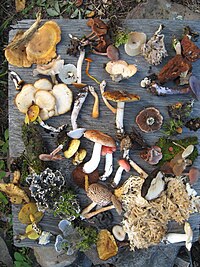
Photo from wikipedia
Biofilms in streams play an integral role in ecosystem processes and function yet few studies have investigated the broad diversity of these complex prokaryotic and eukaryotic microbial communities. Physical habitat… Click to show full abstract
Biofilms in streams play an integral role in ecosystem processes and function yet few studies have investigated the broad diversity of these complex prokaryotic and eukaryotic microbial communities. Physical habitat characteristics can affect the composition and abundance of microorganisms in these biofilms by creating microhabitats. Here we describe the prokaryotic and eukaryotic microbial diversity of biofilms in sand and macrophyte habitats (i.e. epipsammon and epiphyton, respectively) in five macrophyte-rich streams in Jutland, Denmark. The macrophyte species varied in growth morphology, C:N stoichiometry, and preferred stream habitat, providing a range in environmental conditions for the epiphyton. Among all habitats and streams, the prokaryotic communities were dominated by common phyla, including Alphaproteobacteria, Bacteriodetes, and Gammaproteobacteria, while the eukaryotic communities were dominated by Stramenopiles (i.e. diatoms). For both the prokaryotes and eukaryotes, the epipsammon were consistently the most diverse communities and the epiphytic communities were generally similar among the four macrophyte species. However, the communities on the least complex macrophyte, Sparganium emersum, had the lowest richness and evenness and fewest unique OTUs, whereas the macrophyte with the most morphological complexity, Callitriche spp., had the highest number of unique OTUs. In general, the microbial taxa were ubiquitously distributed across the relatively homogeneous Danish landscape as determined by measuring the similarity among communities (i.e. Sorensen similarity index). Furthermore, we found significant correlations between microbial diversity (i.e. Chao1 rarefied richness and Pielou's evenness) and biofilm structure and function (i.e. C:N ratio and ammonium uptake efficiency, respectively); communities with higher richness and evenness had higher C:N ratios and lower uptake efficiency. In addition to describing the prokaryotic and eukaryotic community composition in stream biofilms, our study indicates that 1) physical habitat characteristics influence microbial diversity and 2) the variation in microbial diversity may dictate the structural and functional characteristics of stream biofilm communities. This article is protected by copyright. All rights reserved.
Journal Title: Oikos
Year Published: 2017
Link to full text (if available)
Share on Social Media: Sign Up to like & get
recommendations!